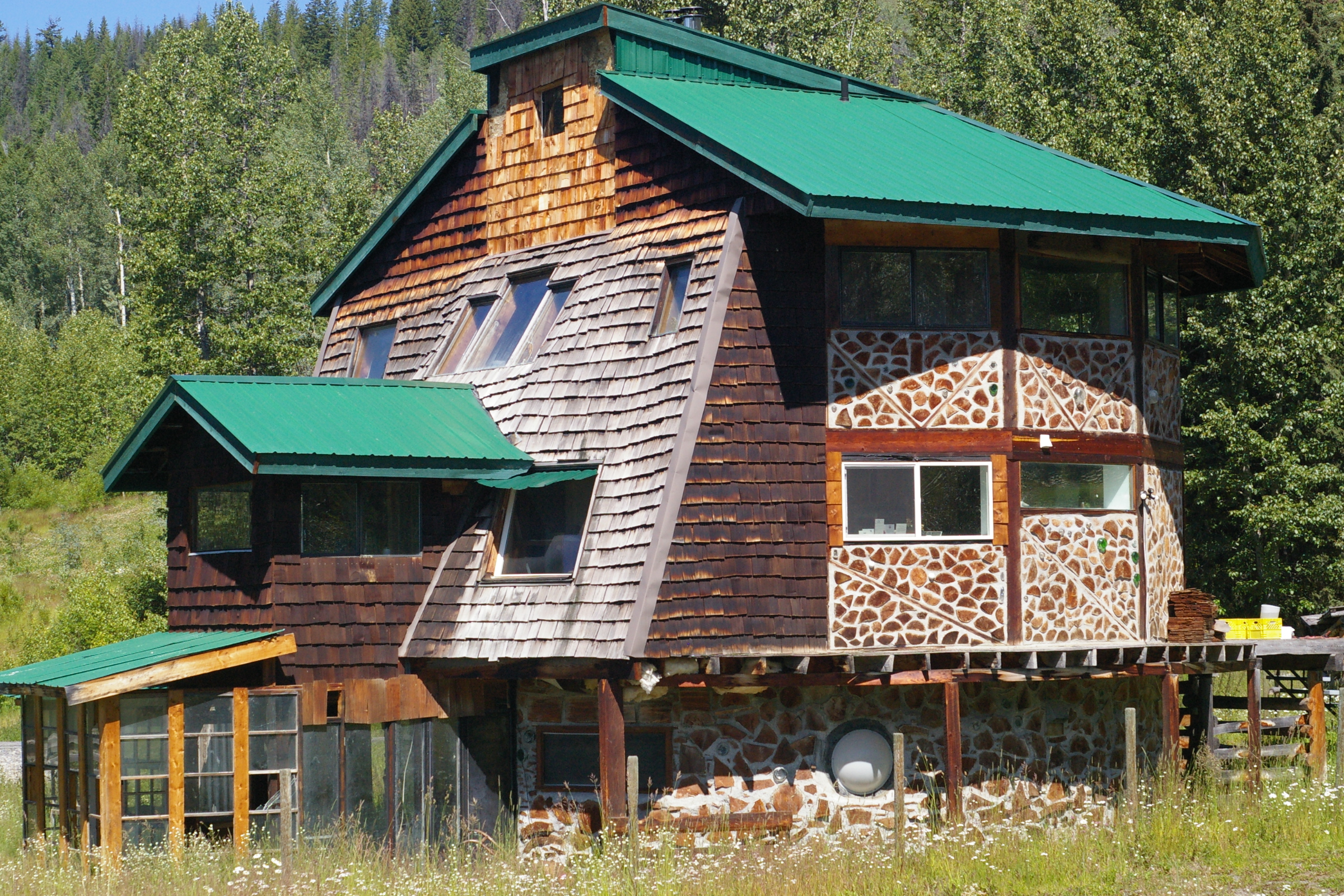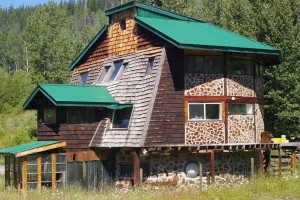
Last summer, I not only had the opportunity to work on an interesting building, I also was fortunate enough to work with an interesting family. As I’m sure you know, the Newtons are currently exploring the continental USA. I’m envious as I’ve always wanted to explore it more fully myself. For the meantime, I will have to settle for their posts about their trip. Before they left, Chris and Sandra encouraged me to keep writing by adding another post to their website. This is a good opportunity for me as it will help me improve my writing skills and better develop my thoughts about the construction industry and sustainability.
While working on the Newton’s home we had many discussions about the merits of earthships and various other alternative building methods. It’s a good way to pass the time while digging a ditch for a water line or adding fill to the tire wall. Since my time there, I’ve been pondering what factors motivate people to consider alternative buildings as their choice of residence or other construction project. Additionally, I wondered why the building industry tends to concentrate on a few types of building methods. Is there opportunity for a large scale implementation of earthship (or other) methodology in construction, or will it always exist somewhere on the periphery of the built world?

For most people you don’t have to go far to find alternatives. In BC there are many examples of homes built with cob, rammed earth, cord wood (figure 1), strawbales and tires. No doubt there are other styles I am unaware of. With so many methods available, it can be quite the task deciding which you will adopt. When the decision is finalized, it will be necessary to navigate the myriad rules and regulations written for standard construction. Fortunately, there many people who have built fine homes using varying techniques and they have provided much free information about the results they achieved. For instance I’ve read with a lot of interest about eco-sense, the cob home built by the Bairds. It is code approved and has been recognized by the living building certification system, a rare achievement. They have provided analysis of their home’s performance as well as a cost breakdown. Similarly, Sandra and Chris have been posting continuously about their project to date and have provided a good source for enthusiasts. There’s no doubt the alternative building community doesn’t lack for information. However, as Chris would say last summer, having access to information does not equate to having knowledge. Knowledge comes through experience and understanding. When given a problem we have to understand what needs to be done and then how to do it. I often wonder how many people look at alternatives with initial excitement, only to be dismayed by their lack of experience and/or ability to discern which method is right for them.

I have found the people that are involved in these projects have an adventurous streak and are almost always concerned with the environment. Alternative buildings often use materials found close to a building site, divert products from the waste stream and try to incorporate less energy consuming technologies in combination with passive design. Naturally, these elements are appealing to the eco-conscious among us. These buildings can also be more economical than their traditional counterparts, especially if given adequate forethought and planning. Of course, it is also necessary to cast aside preconceptions of what a building should be built of. If you look at Sandra and Chris’ expenses to date, they have accomplished a lot without excessive expenditure or acquiring any debt. Concurrently, the Bairds found their home was 46.5% less expensive to build when compared to average homes in BC, AB, NWT, and YT. Both these building projects are/were self-managed and benefit from not having to pay middle-man costs. However, these factors alone do not account for the total cost reductions. In an email, the Baird’s explained that they were able to reduce their costs by not having to purchase as many manufactured materials. Similarly, the Newton’s have used earth from their property, as well as reused manufactured products (Figure 2) that were acquired for free or relatively cheaply. By being actively involved in every aspect of their home’s construction, both the Newton’s and the Baird’s are constantly looking at all the options and assess them with regard to performance and cost. Of course, not everyone is going to be comfortable with building their home on their own but by being open-minded about the materials with the potential for utilization, a home that seemed out of reach for many can become achievable.
Despite the aforementioned advantages, these buildings have not impacted the market significantly. Stick framing is the method of choice for most homes and there hasn’t been much indication of this changing. The markets demand standardization. It’s understandable that those who make their living from standard construction would be hesitant to contemplate new methods. These could expose them to risks they don’t understand and can otherwise avoid. Furthermore, culturally we are moving away the idea that homes should be multigenerational. They are increasingly viewed as investment opportunities and often turned over rapidly. Since alternatives make up such a small portion of the market, it is hard to estimate their value. This reality can make them unappealing to investment savvy buyers. Today’s buyers also expect certain aesthetics and features that are not necessarily apparent in buildings of alternative design.
It’s not possible to determine the future of alternatives as they are now but I suspect their use will continue to increase slowly. Some mainstream projects have started to incorporate these methods. Just a 25 min bike ride from where I live, the new the Van Dusen Gardens Visitor Centre in Vancouver used rammed earth for some of its walls. It is expected to receive certification as a Living Building. Additionally, innovative companies are starting to develop products based on alternatives. Modcell, for example, builds pre-fabricated strawbale walls and has helped to create some very appealing institutional, commercial and residential buildings. Examples like these expose people to alternatives and green design in general. Until the public begins to view such methods as viable options, alternatives will remain well… alternative. I am eager to see how this sector of the built environment develops and I look forward to hearing the community’s views on the subject.
When I decided to ride a bike to work, I didn’t say to myself, “I’m an environmentalist, so this must be the thing to do.” The whole picture just made sense most of the time. Most people don’t bike to work or school. The big picture for me made sense to me, so I continued to do it 15 years later now. People routinely think I’m 30-35, even though I’m 47. That didn’t persuade anybody either. A number of people developed spinal disc problems resulting from a sedentary lifestyle. That didn’t persuade anybody I know of. I could still get in an accident and die, but that could happen in a car too if somebody was driving too fast or was simply hit by someone else. It was a combination of factors: not be a slave to a loan payment to a bank; get some much needed exercise; no fuel requirements; parts of the earth don’t have to be ripped up to sustain this lifestyle as much as other lifestyles, etc. It’s the same with earthships. Maybe it isn’t perfect. An earthship is not portable, but makes a lot of sense and is functional. What if I bought cinder blocks and built a house out of cinder blocks. Are they more sacred blocks than used tires? My opinion is if it holds up the building fine and “takes care of me”, then they’re fine.
Are you worried what other people think? People are slaves of other peoples’ opinions. Are you afraid to be seen carrying used vodka bottles? even if it provided a nice house? People will always be slaves of public opinion. Does it build a decent house that you can find shelter in and stay warm? That’s the big question. If you’re looking for the answers in the general public, you’ll definitely be disappointed. Think function, what achieves your goal, then you can be content. The Western world is now run by banking interests. They cannot make much money off of persuading people to build houses out of common used tires or discarded vodka bottles, so don’t expect it to get much media coverage. Maybe the only exception is if they want to popularize the idea of banks collecting global carbon taxes and making an austere lifestyle trendy while they’re collecting the taxes subsidizing their luxurious lifestyle. That’s the only situation where the general media will promote voluntarily cutting back.
Hey,
Tried contacting you at your e-mail addy and it not longer seems to work (northriverloghomes)
What I was wonfering was how the temperature in the earthship has been this winter?
Thanks!
Try chris@darfieldearthship.com We dropped the northriverloghomes domain…